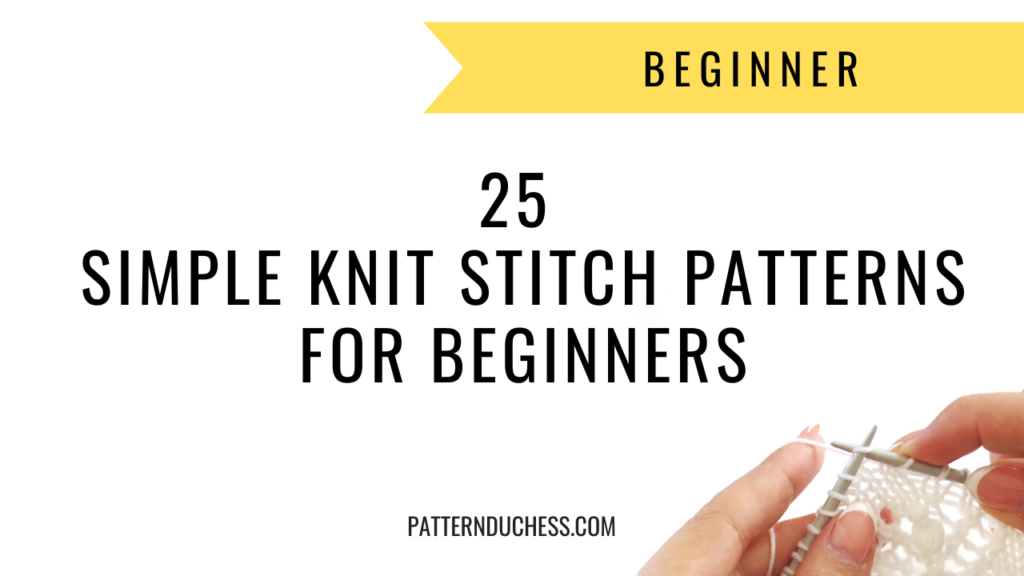
Simple (and free) knit stitch patterns for beginners to try are something that has been on my mind for a long time. I remember when I started to knit. You can do the Garter and Stockinette stitch only in a certain amount of time.
But these stitch patterns don’t have to be beginners only – they will be interesting for advanced knitters as well (although you might already know many of them). More advanced and interesting patterns get tiring sometimes. Or maybe you just want to watch TV and knit something mindlessly 🙂
All of today’s patterns are using two knitting techniques – knit and purl. Easy right? (and no, not boring.) You might be surprised by what you can do with only two types of knitting methods.
Before we continue I have a disclaimer to make. These are the patterns my grandmother taught me when I started to learn knitting. I don’t know the correct names, and though I tried to research, I have no idea if they are all “proper” stitch names.
Abbreviations
- RS – right side;
- WS – wrong side;
- st(s) – stitch(es);
- k – knit;
- p – purl;
- rep – repeat;
Stitch #1
Moss stitch
For symmetry, work on a multiple of 2+1 stitches, and an additional 1 edge stitch on each side. The pattern is given for the main pattern and edge stitches are not included.

- Row 1 (RS): (k1, p1) rep to last stitch, k1.
- Row 2 (WS): (k1, p1) rep to last stitch, k1.
Repeat rows 1 to 2 to form a pattern.
The logic behind it is that you will alternate the stitches on each row – knit the purl stitches as they appear, and purl the knit stitches.
Stitch #2
Double moss stitch
For symmetry, work on a multiple of 2+1 stitches, and an additional 1 edge stitch on each side. The pattern is given for the main pattern and edge stitches are not included.

- Row 1 (RS): (k1, p1) rep to last stitch, k1.
- Row 2 (WS): (k1, p1) rep to last stitch, k1.
- Row 3: (p1, k1) rep to last stitch, p1.
- Row 4: (p1, k1) rep to last stitch, p1.
Repeat rows 1 to 4 to form a pattern (alternating the stitches every 2 rows).
Stitch #3
1/1 Rib
For symmetry, work on a multiple of 2+1 stitches, and an additional 1 edge stitch on each side. The pattern is given for the main pattern and edge stitches are not included.

- Row 1 (RS): (k1, p1) rep to last stitch, k1.
- Row 2 (WS): (p1, k1) rep to last stitch, p1.
Repeat rows 1 to 2 to form a pattern.
Stitch #4
2/2 Rib
For symmetry, work on a multiple of 4+2 stitches, and an additional 1 edge stitch on each side. The pattern is given for the main pattern and edge stitches are not included.

- Row 1 (RS): (k2, p2) rep to last 2 stitches, k2.
- Row 2 (WS): (p2, k2) rep to last 2 stitches, p2.
Repeat rows 1 to 2 to form a pattern.
Stitch #5
5/1 Rib
For symmetry, work on a multiple of 6+5 stitches, and an additional 1 edge stitch on each side. The pattern is given for the main pattern and edge stitches are not included.

- Row 1 (RS): (k5, p1) rep to last 5 stitches, k5.
- Row 2 (WS): (p5, k1) rep to last 5 stitches, p5.
Repeat rows 1 to 2 to form a pattern.
Stitch #6
3/3 Garter Stitch Rib
For symmetry, work on a multiple of 6+3 stitches, and an additional 1 edge stitch on each side. The pattern is given for the main pattern and edge stitches are not included.

- Row 1 (RS): knit all stitches.
- Row 2 (WS): p3, (k3, p3) rep to end.
Repeat rows 1 to 2 to form a pattern.
Stitch #7
Broken Rib
For symmetry, work on a multiple of 2+1 stitches, and an additional 1 edge stitch on each side. The pattern is given for the main pattern and edge stitches are not included.

- Row 1 (RS): knit all stitches.
- Row 2 (WS): p1, (k1, p1) rep to end.
Repeat rows 1 to 2 to form a pattern.
Stitch #8
Granite Stitch
For symmetry, work on a multiple of 2+1 stitches, and an additional 1 edge stitch on each side. The pattern is given for the main pattern and edge stitches are not included.

- Row 1 (RS): knit all stitches.
- Row 2 (WS): purl all stitches.
- Row 3: (p1, k1) rep to last st, p1.
- Row 4: (k1, p1) rep to last st, k1.
- Row 5: knit all stitches.
- Row 6: purl all stitches.
- Row 7: (k1, p1) rep to last st, k1.
- Row 8: (p1, k1) rep to last st, p1.
Repeat rows 1 to 8 to form a pattern.
Stitch #9
Seersucker Stitch
For symmetry, work on a multiple of 4+1 stitches, and an additional 1 edge stitch on each side. The pattern is given for the main pattern and edge stitches are not included.

- Row 1 (RS): (k1, p1, k1, p1) rep to last st, k1.
- Row 2 (WS): (p1, k1, p1, k1) rep to last st, p1.
- Row 3: (p1, k3) rep to last st, p1.
- Row 4: (k1, p3) rep to last st, k1.
- Row 5: (k1, p1, k1, p1) rep to last st, k1.
- Row 6: (p1, k1, p1, k1) rep to last st, p1.
- Row 7: (k2, p1, k1) rep to last stitch, k1.
- Row 8: (p2, k1, p1) rep to last stitch, p1.
Repeat rows 1 to 8 to form a pattern.
Stitch #10
Garter Stitch Ridges

- Row 1 (RS): knit all stitches.
- Row 2 (WS): purl all stitches.
- Row 3: knit all stitches.
- Row 4: knit all stitches.
- Row 5: purl all stitches.
- Row 6: knit all stitches.
Repeat rows 1 to 6 to form a pattern.
Stitch #11
Stockinette Stitch With Garter Ridge

- Row 1 (RS): knit all stitches.
- Row 2 (WS): purl all stitches.
- Row 3: knit all stitches.
- Row 4: knit all stitches.
Repeat rows 1 to 4 to form a pattern.
Stitch #12
Garter Stitch Rectangles
For symmetry, work on a multiple of 14+7 stitches, and an additional 1 edge stitch on each side. The pattern is given for the main pattern and edge stitches are not included.

- Row 1 (RS): knit all stitches.
- Row 2 (WS): knit all stitches.
- Row 3: knit all stitches.
- Row 4: k7, (p7, k7) rep to end.
- Row 5: knit all stitches.
- Row 6: knit all stitches.
- Row 7: knit all stitches.
- Row 8: p7, (k7, p7) rep to end.
Repeat rows 1 to 8 to form a pattern.
Stitch #13
Cobblestones
For symmetry, work on a multiple of 18+5 stitches, and an additional 1 edge stitch on each side. The pattern is given for the main pattern and edge stitches are not included.

- Row 1 (RS): knit all stitches.
- Row 2 (WS): purl all stitches.
- Row 3: knit all stitches.
- Row 4: purl all stitches.
- Row 5: (k9, p5, k4) rep to last 5 sts, k5.
- Row 6: (p9, k5, p4) rep to last 5 sts, p5.
- Row 7: (k9, p5, k4) rep to last 5 sts, k5.
- Row 8: (p9, k5, p4) rep to last 5 sts, p5.
- Row 9: (k9, p5, k4) rep to last 5 sts, k5.
- Row 10: (p9, k5, p4) rep to last 5 sts, p5.
- Row 11: knit all stitches.
- Row 12: purl all stitches.
- Row 13: knit all stitches.
- Row 14: purl all stitches.
- Row 15: knit all stitches.
- Row 16: purl all stitches.
- Row 17: (p5, k13) rep to last 5 sts, p5.
- Row 18: (k5, p13) rep to last 5 sts, k5.
- Row 19: (p5, k13) rep to last 5 sts, p5.
- Row 20: (k5, p13) rep to last 5 sts, k5.
- Row 21: (p5, k13) rep to last 5 sts, p5.
- Row 22: (k5, p13) rep to last 5 sts, k5.
- Row 23: knit all stitches.
- Row 24: purl all stitches.
Repeat rows 1 to 8 to form a pattern.
Stitch #14
5/5 Checks
For symmetry, work on a multiple of 10+5 stitches, and an additional 1 edge stitch on each side. The pattern is given for the main pattern and edge stitches are not included.

- Row 1 (RS): (k5, p5) rep to last 5 sts, k5.
- Row 2 (WS): (p5, k5) rep to last 5 sts, p5.
- Row 3: (k5, p5) rep to last 5 sts, k5.
- Row 4: (p5, k5) rep to last 5 sts, p5.
- Row 5: (k5, p5) rep to last 5 sts, k5.
- Row 6: (p5, k5) rep to last 5 sts, p5.
- Row 7: (k5, p5) rep to last 5 sts, k5.
- Row 8: k5, (p5, k5) rep to end.
- Row 9: (p5, k5) rep to last 5 sts, p5.
- Row 10: k5, (p5, k5) rep to end.
- Row 11: (p5, k5) rep to last 5 sts, p5.
- Row 12: k5, (p5, k5) rep to end.
- Row 13: (p5, k5) rep to last 5 sts, p5.
- Row 14: k5, (p5, k5) rep to end.
Repeat rows 1 to 14 to form a pattern.
You can modify this pattern by varying the number of stitches and rows in each square.
Stitch #15
Basket Weave
For symmetry, work on a multiple of 6+2 stitches, and an additional 1 edge stitch on each side. The pattern is given for the main pattern and edge stitches are not included.

- Row 1 (RS): knit all stitches.
- Row 2 (WS): purl all stitches.
- Row 3: (k2, p4) rep to last 2 sts, k2.
- Row 4: (p2, k4) rep to last 2 sts, p2.
- Row 5: (k2, p4) rep to last 2 sts, k2.
- Row 6: (p2, k4) rep to last 2 sts, p2.
- Row 7: knit all stitches.
- Row 8: k5, purl all stitches.
- Row 9: (p3, k2, p1) rep to last 2 sts, p2.
- Row 10: k2, (k1, p2, k3) rep to end.
- Row 11: (p3, k2, p1) rep to last 2 sts, p2.
- Row 12: k2, (k1, p2, k3) rep to end.
Repeat rows 1 to 12 to form a pattern.
Stitch #16
Interrupted Rib 1
For symmetry, work on a multiple of 4+2 stitches, and an additional 1 edge stitch on each side. The pattern is given for the main pattern and edge stitches are not included.

- Row 1 (RS): (k2, p2) rep to last 2 stitches, k2.
- Row 2 (WS): (p2, k2) rep to last 2 stitches, p2.
- Row 3: purl all stitches.
- Row 4: knit all stitches.
Repeat rows 1 to 4 to form a pattern.
Check the wrong side too. Quite interesting.
Stitch #17
Woven Rib
For symmetry, work on a multiple of 12 stitches, and an additional 1 edge stitch on each side. The pattern is given for the main pattern and edge stitches are not included.

- Row 1 (RS): knit all stitches.
- Row 2 (WS): purl all stitches.
- Row 3: knit all stitches.
- Row 4: purl all stitches.
- Row 5: (k3, p6, k3) rep to end.
- Row 6: (p3, k6, p3) rep to end.
- Row 7: (k3, p6, k3) rep to end.
- Row 8: (p3, k6, p3) rep to end.
Repeat rows 1 to 8 to form a pattern.
Stitch #18
5/5 Garter Stitch Checks
For symmetry, work on a multiple of 10+5 stitches, and an additional 1 edge stitch on each side. The pattern is given for the main pattern and edge stitches are not included.

- Row 1 (RS): (k5, p5) rep to last 5 sts, k5.
- Row 2 (WS): purl all stitches.
- Row 3: (k5, p5) rep to last 5 sts, k5.
- Row 4: purl all stitches.
- Row 5: (k5, p5) rep to last 5 sts, k5.
- Row 6: purl all stitches.
- Row 7: (k5, p5) rep to last 5 sts, k5.
- Row 8: k5, (p5, k5) rep to end.
- Row 9: knit all stitches.
- Row 10: k5, (p5, k5) rep to end.
- Row 11: knit all stitches.
- Row 12: k5, (p5, k5) rep to end.
- Row 13: knit all stitches.
- Row 14: k5, (p5, k5) rep to end.
Repeat rows 1 to 8 to form a pattern.
Stitch #19
Grid Stitch
For symmetry, work on a multiple of 2+1 stitches, and an additional 1 edge stitch on each side. The pattern is given for the main pattern and edge stitches are not included.

- Row 1 (RS): (k1, p1) rep to last st, k1.
- Row 2 (WS): (p1, k1) rep to last st, p1.
- Row 3: knit all stitches.
- Row 4: knit all stitches.
Repeat rows 1 to 4 to form a pattern.
Stitch #20
Interrupted Rib 2
For symmetry, work on a multiple of 4+2 stitches, and an additional 1 edge stitch on each side. The pattern is given for the main pattern and edge stitches are not included.

- Row 1 (RS): (k2, p2) rep to last 2 stitches, k2.
- Row 2 (WS): (p2, k2) rep to last 2 stitches, p2.
- Row 3: knit all stitches.
- Row 4: knit all stitches.
Repeat rows 1 to 4 to form a pattern.
Stitch #21
Squares
For symmetry, work on a multiple of 5+4 stitches, and an additional 1 edge stitch on each side. The pattern is given for the main pattern and edge stitches are not included.

- Row 1 (RS): knit all stitches.
- Row 2 (WS): p4, (k1, p4) rep to end.
- Row 3: knit all stitches.
- Row 4: p4, (k1, p4) rep to end.
- Row 5: knit all stitches.
- Row 6: knit all stitches.
Repeat rows 1 to 6 to form a pattern.
Stitch #22
Diagonal to the left
For symmetry, work on a multiple of 6 stitches, and an additional 1 edge stitch on each side. The pattern is given for the main pattern and edge stitches are not included.

- Row 1 (RS): (p1, k5) rep to end.
- Row 2 (WS): (p5, k1) rep to end.
- Row 3: (k1, p1, k4) rep to end.
- Row 4: (p4, k1, p1) rep to end.
- Row 5: (k2, p1, k3) rep to end.
- Row 6: (p3, k1, p2) rep to end.
- Row 7: (k3, p1, k2) rep to end.
- Row 8: (p2, k1, p3) rep to end.
- Row 9: (k4, p1, k1) rep to end.
- Row 10: (p1, k1, p4) rep to end.
- Row 11: (k5, p1) rep to end.
- Row 12: (k1, p5) rep to end.
Repeat rows 1 to 12 to form a pattern.
Stitch #23
Diagonal to the right
For symmetry, work on a multiple of 4 stitches, and an additional 1 edge stitch on each side. The pattern is given for the main pattern and edge stitches are not included.

- Row 1 (RS): (k2, p2) rep to end.
- Row 2 (WS): (k2, p2) rep to end.
- Row 3: (k1, p2, k1) rep to end.
- Row 4: (p1, k2, p1) rep to end.
- Row 5: (p2, k2) rep to end.
- Row 6: (p2, k2) rep to end.
- Row 7: (p1, k2, p1) rep to end.
- Row 8: (k1, p2, k1) rep to end.
Repeat rows 1 to 8 to form a pattern.
Stitch #24
Fake cables to the right
For symmetry, work on a multiple of 6 stitches, and an additional 1 edge stitch on each side. The pattern is given for the main pattern and edge stitches are not included.

- Row 1 (RS): (k4, p2) rep to end.
- Row 2 (WS): (k2, p4) rep to end.
- Row 3: (k4, p2) rep to end.
- Row 4: (k2, p4) rep to end.
- Row 5: (k2, p2, k2) rep to end.
- Row 6: (p2, k2, p2) rep to end.
- Row 7: (k2, p2, k2) rep to end.
- Row 8: (p2, k2, p2) rep to end.
- Row 9: (p2, k4) rep to end.
- Row 10: (p4, k2) rep to end.
- Row 11: (p2, k4) rep to end.
- Row 12: (p4, k2) rep to end.
Repeat rows 1 to 12 to form a pattern.
Stitch #25
Diamonds
For symmetry, work on a multiple of 8+1 stitches, and an additional 1 edge stitch on each side. The pattern is given for the main pattern and edge stitches are not included.

- Row 1 (RS): (p1, k7) rep to last st, p1.
- Row 2 (WS): p1, (k1, p5, k1, p1) rep to end.
- Row 3: (k2, p1, k3, p1, k1) rep to last st, k1.
- Row 4: p1, (p2, k1, p1, k1, p3) rep to end.
- Row 5: (k4, p1, k3) rep to last st, k1.
- Row 6: p1, (p2, k1, p1, k1, p3) rep to end.
- Row 7: (k2, p1, k3, p1, k1) rep to last st, k1.
- Row 8: p1, (k1, p5, k1, p1) rep to end.
Repeat rows 1 to 8 to form a pattern.
If you liked my chosen knit stitch patterns for beginners and would like to receive new stitch ideas weekly then subscribe to my knitting newsletter “Knitlet”. I spend a lot of time trying out different stitch patterns for my full patterns and KALs, and I thought it might be interesting to you too. But that’s not all.
“Knitlet” also has new updates from the blog, news about my pattern releases (with special discounts of course), and everything else knitting related I might come across to and you might be interested in. But the focus is on the stitch patterns.
If this is something you would like to be a part of, leave your name and email address HERE and I’ll make sure the next “Knitlet” I’ll send out will be in your Inbox too (just ensure you’ll confirm the address once you’re opted in).
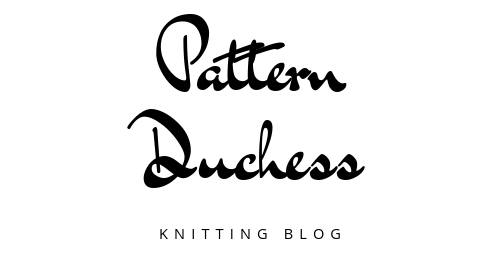
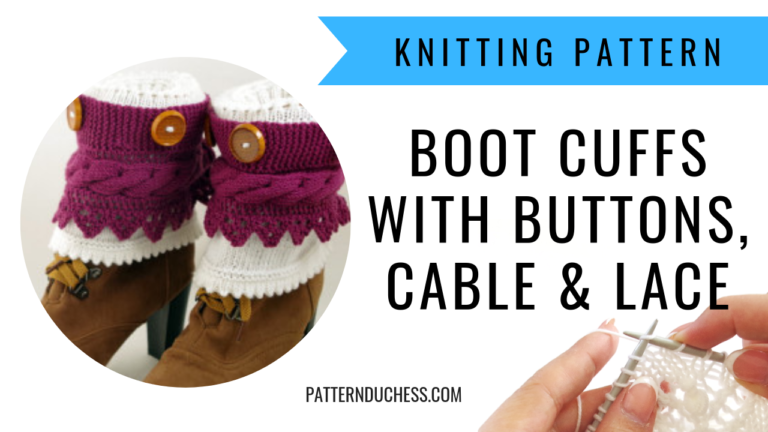
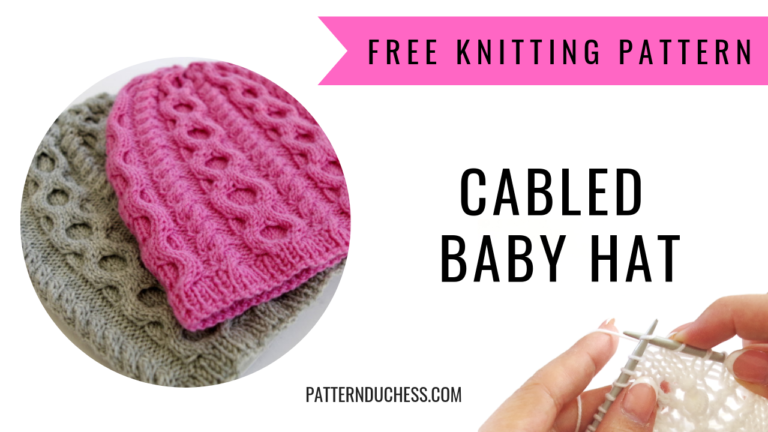
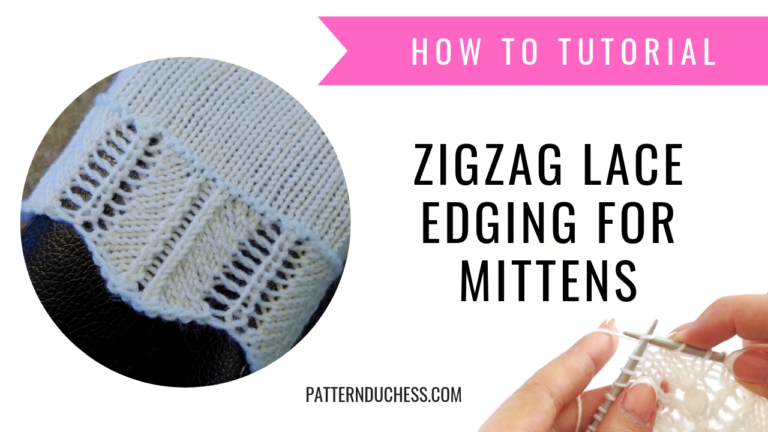
For such fine work, what needles do I need? And to correspond with how many ply wool.
I think it depends on what you’d like to knit. To just try out the patterns I would recommend some sock yarn (fingering weight) and maybe 3 mm needles.
Hi! I am a complete beginner but loving these stitch patterns. May you just explain what you mean by ‘For symmetry, work on a multiple of 2+1 stitches’. Thanks so much!
Sure! This means that pattern repeat is 2 sts and you need to add 1 extra stitch for “ending the pattern”. For example, let’s say you want to have that pattern over 24 sts (12 pattern repeats), then you’ll need to add that 1 extra stitch -> therefore you’ll cast on 25 sts.
Does that make sense?
What about 4+2 pattern? Does it mean pattern repeats every 6? How many would I cast on? For symmetrical pattern including the edge stitching?
Also, do you start the pattern after you cast on or do you knit a row of knit stitch?
4+2 means that pattern repeat is 4 stitches – you will repeat those 4 sts until you have 2 sts left. You would cast on 4 sts repeats + 2 extra sts (e.g. 16+2 or 40+2 etc.). Usually, edges are not included in the pattern. I prefer to work one or two rows before I start the pattern, but it’s a matter of preference. You can start after cast on.
24 is very lovely effet and i’ll try to do it. Thank you so much
Pattern 24 is very interesting n beautiful…I am going to make a blanket for my grand son …thanxs for sharing…looking forward for more
You say in each pattern to leave an edge stitch for each side, how do we do this stitch?
Just slip the first stitch and knit the last stitch.
I am a 40 year knitter and do lots of designing. You shared some stitch patterns that I have never seen. Thank you so much. Can not wait to try them
I’m glad there’s something new for you.
Thank you for your simple and lucid designs.
Love pattern 23. I’ve been knitting for over 50 years. I knit Aran Jumpers and Blankets. This stitch is amazing in a blanket that I have just made. I used it to create chevrons slanting to the right and then reversing the pattern to slant to the left. Thank you so much. I haven’t found a new stitch for years and I find it on a beginners page 🙂
Ah ok! Thank you for your reply! I appreciate this very much.
I am currently working on the first pattern, 2+1. I understand this one. Casted on 27 stitches. Slip the 1st stitch, then the 2 stitch pattern and knitted the last stitch.
But the 4+2, 10+5, 5+4 and additional 1 stitch for edging confuses me. So, in a 4+2 pattern, the two stitches act as edges?
For example, cast on 40+2, do I slip the the first stitch, then do the 4 stitch pattern, followed by knitting the last stitch?
Sorry for really asking stupid questions. I am a super beginner it comes to knitting patterns
For example, if there are 40+2 then those 2 sts are a part of a pattern (to finish the pattern for symmetry). If you want to have edge stitches (for loopy edges for example) then you need to cast on 40 sts (main pattern) + 2 sts (for pattern symmetry) + 2 sts (for edges).
det første mønster hedder perlestrik, nr 2 således dobbelt perlestrik.